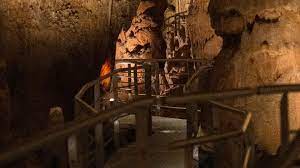The prehistoric ‘human skull’ cave of Greece at Petralona reopens

Athens: The Petralona cave in Chalkidiki, Greece is open to the public again after five years, while the ceremonial opening is expected to take place in a few days by Greek Minister of Culture, Lina Mendoni.
The project “Uncovering the Petralona Cave and Upgrading its Infrastructure” started in 2019 overlooked by the Paleoanthropology-Speleology Ephorate of the Ministry of Culture.

The Athens-Macedonian News Agency spoke to the head of the Paleoanthropology-Speleology Ephorate, Andreas Darlas about the works done in the cave that has seen thousands of visitors since the 1970s when it opened for the public.
The corridor was widened and now extends to 250 meters. During work to widen the corridor, it was possible to carry out excavation documentation for the first time.
With an area of approximately 10,000 sq.m. but accessible to 10 percent to 20 percent, the Petralona cave is estimated to have been formed more than a million years ago. It was a place where foragers took refuge. Also, wild animals, such as lions, bears and hyenas took shelter there, as evidenced by the majority of fossils found.
Inside the Petralona cave there is a large “hall”, known as the “Cave of red stones” because the red color from the iron oxides prevails.
As part of the work, the lighting of the cave was important, as Darlas explains: “Caves are a world of darkness and that’s why we paid special attention to the lighting, which is adjustable and gives the required feeling.”
Darlas added that the temperature and humidity inside the cave are recorded in real time while an intercom was installed in certain points and closed circuit television.
A unique rare find to which the Petralona Museum owes much of its fame and attendance is the human skull found in 1960.
“The skull was found stuck at a height, that is, it was not on the floor and it was in very good condition,” Darlas said. “But the issue is that it was found by an area resident who unglued it and brought it to the surface and to the scientists.”
However, when the finder indicated the spot where he found the skull, it was certain that valuable evidence had been lost since its discovery was not made by experts who would have provided more scientific evidence based on its exact location.id Mr.
“Its uniqueness also lies in the fact that it was almost intact,” Darlas said.
The skull of Petralona is placed in the species Homo heidelbergensis. This species has a series of skulls that essentially include all forms, which constitute the transition from Homo erectus to Homo sapiens and are referred to as archaic Homo sapiens.
Anthropologist Aris Poulianos, who dealt with the find for many years, estimated that this is the oldest European and called him “Archman”. The dating of the skull became a matter of controversy and was at the center of the years-long struggle over the operation of the cave.
“The issue is that the cave was inhabited by people, something that has been disputed. Since remains, tools and the by-products of the manufacture of stone tools were found, then it is an archaeological site,” clarifies Mr. Darlas.
The first findings of the cave, from the 1960s to the mid-70s and the famous skull, are kept in the Museum of Geology – Paleontology – Paleoanthropology.
“The skull is a paleontological find, it is not archaeological. Archaeologists deal with the cultural manifestations of man, we deal with the bones, with natural anthropology,” Professor of Paleontology at the Aristotle University of Thessaloniki Evangelia Tsoukala told AMNA.
Chronologically the skull in the Petralona Cave has been determined to be 200,000 years old, but it is not its age but its state of preservation that makes it unique on the planet. “It was found whole and the studies are still ongoing and inside its intracranial imprint” Tsoukala said.





